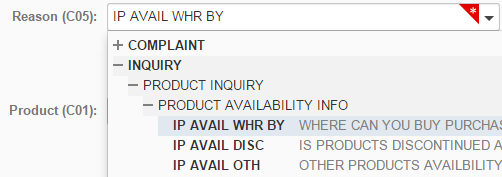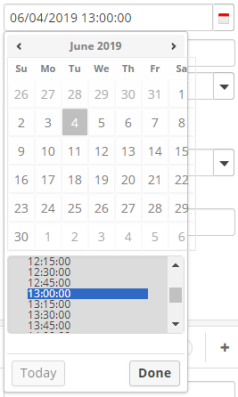Codes and Browsing
Codes are a predefined set of possible values that can be entered into a field. Not all fields use codes, but many do. A field that uses codes can have as few as two possible values or there could be thousands.
For fields that have many codes, the values are often defined in a hierarchy. Code hierarchies are presented in a folder structure that can be anywhere from one to six levels deep. Each level in the hierarchy drills down from less-specific to more-specific, until you get to the actual code value. For example, all of the stores for a given company may be stored in a hierarchy that is broken down as follows:
Region > State > City > Store
Fields that use codes are identified by a small down-arrow button to the right of the field.

Browsing for Codes
You can easily browse the hierarchy for any code field.
To activate the browse, do one of the following:
Click the arrow to the right of the field.
Or
While in the field, press [Ctrl+B].
The following is an example of a four-level hierarchy:

Click the +/- icons to expand or close an individual level in the hierarchy. In addition, you can use your keyboard arrow keys to navigate, expand, and collapse the levels in the hierarchy.
After applying Dependent and Limit Code rules, when a level in the hierarchy (also known as a folder) is only one level deep, the folder is automatically expanded and the contents are displayed. The levels are expanded until the code level is displayed or there are multiple folders.
To select a code value to enter into the field, simply click it.
Entering Partial Codes
You can enter just the first few characters of a code into a field. When you tab out of the field, one of the following will occur:
If the characters you entered are sufficient to uniquely identify a single code, the full code is entered into the field.
If the characters you entered match more than one code, a special browse window is displayed with all of the matching values. You can select a value from the list, and it is entered into the field. This is also referred to as a "partial code browse."
If the characters you entered did not match any codes, a message will display notifying you of that fact. When you close the message, you are returned to the field where you can enter a different value.
Some fields have a minimum number of characters that you must enter before a partial code browse is performed. This is especially true in a field with many codes where entering only one or two characters could match hundreds or thousands of values.
Browsing for a Case ID
Certain fields may allow you to enter a reference to another Case ID within your system. These fields behave slightly different than regular code fields.
The value that is entered in the field is checked to ensure that it is a valid integer value. If it's not valid, you will receive a message and are required to change the value before you can proceed.
The value that is entered in the field is checked to see if it refers to an existing case. If it doesn't refer to an existing case, you receive a warning message. However, you are still allowed to proceed with the value as it has been entered.
Browsing for a Date
Although a date is not a code, it is important to know how to enter dates in the system. The format of the date and time is dependent on the system parameter setting and the category type.
In any date field, you can enter an integer instead of a date. If the integer is 0, it will set the field to the current date and time. If the integer is negative, it will set the date to that number of days ago. For example, if it is currently 8:30 A.M., entering "-1" will set the field to yesterday at 8:30 A.M. Entering "1" will set the field to 8:30 A.M. tomorrow.
There is no limit on the range of acceptable integers that can be entered; however, you will receive and error message if the date entered is before December 31, 99 AD or after December 31, 9999 AD.
You have two options when entering a date:
Manually type the date.
Click the Calendar button next to the field.

You can perform any of the following from the calendar menu:
Click the arrow on either side of the month and year (at the top of the calendar menu) to page through the months.
Click a date to select it.
Use the scroll bar to select the correct time. The time defaults to the closet current time and is listed in 15 minute increments.
Click Done to enter the date and time currently selected on the calendar.
Click Today to enter the current date in the calendar.
Category Code Text Search
The Category Code Text Search allows you to enter a word into a field on a case. When you tab out of the field (if the category code has been defined using the Category Code Text Search), the system performs a search for the entered words. The system searches all text associated with the code and returns a unique match or a list of matching codes. If a list is presented to the agent, the agent can right-click on any of the codes to show the text search associated with the code. If multiple words are used to search, the system searches for any code that has text that matches any combination of the words entered. The results are returned and are ranked based on how many of the words are associated to the code. For further information on how to set up the Category Code Text Search, refer to "Category Code Text Search Overview" in the Administrator's Guide.
For more specific searching, you can use "or," "and," or "not."
Examples
An agent wants to find an address with the words “Columbus,” “Corporate,” and “Exchange."
Enter the following:["columbus" and "corporate" and "exchange"]
An agent wants to find an address with any one of these words entered as text search.
Enter the following:["columbus" or "corporate" or "exchange"]
An agent wants to find an address that includes specific words entered as text, but exclude other words.
Enter the following:["columbus" and not "corporate"]
Categories that are defined as a "Same As" to another category will not make use of the code text search feature.
